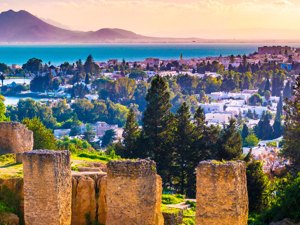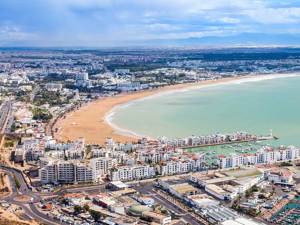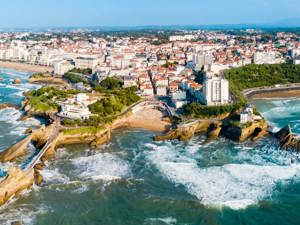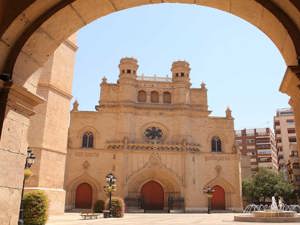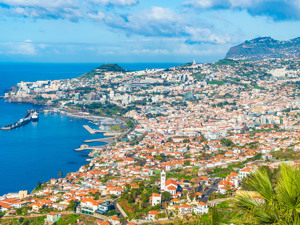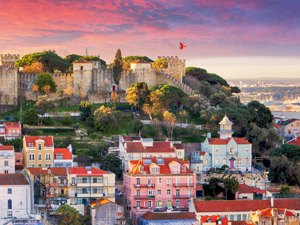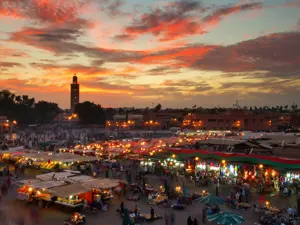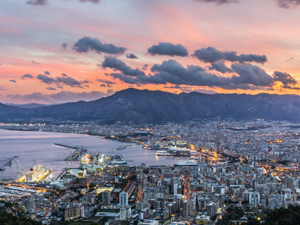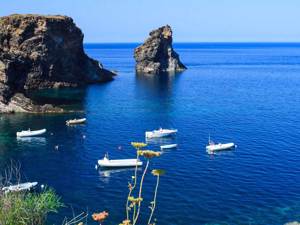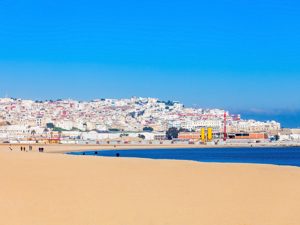Enchanting attractions
On the tip of a small rocky peninsula that delimits the Gulf of Hammamet lies Monastir, one of Tunisia’s most hospitable destinations. This tourist destination par excellence extends northwards to the beach and bathing area of Skanes, with its long series of hotels and resorts. A trip along the panoramic road reveals long, fine sandy beaches and the magnificent Cap-Monastir Marina.

Monastir Copyright © Sisterscom.com, Shutterstock
Monastir was founded by the Phoenicians as a port city; later the great Julius Caesar camped here before preparing for the great battle of Tapso in the year 46 AD.

View of the ancient Ribat fortress at sunset in Monastir Copyright © Sisterscom.com, Shutterstock
This beautiful city is today known, above all, as a city of the sea; it is also an important university city. Its position on a promontory has made it a strategic location for both industry and tourism. There are many large hotel complexes and small souvenir shops disseminated throughout the city. And into the cobbled streets of the Medina there are the souks where you can shop fragrant spices and handicrafts such as leather bags, blankets or woven baskets but also a carpet from Kairouan, silver jewelery, a copper platter, earthenware jars or multicoloured ceramic in the Tunisian style.

Ribat of Harthema Copyright © Sisterscom.com, Shutterstock
Ribat of Harthema
The main attraction of this delightful city is the famous Ribat of Harthema, a fortified Islamic monastery built in 796 as a fortress, and the first example of a ribat on the African continent. Today the courtyard is used for theatre performances and evening shows. In 1976 the director Franco Zeffirelli used the ribat as the location for several scenes of his film “Jesus of Nazareth”.

Mausoleo di Bourguiba Copyright © Sisterscom.com, Shutterstock
The mosques of Monastir
Don’t miss a visit to the large IX century Mosque located next to the ribat, which was rebuilt in the XI century. Another important building is the Bourguiba Mosque, which was built in 1963 to the north-west of the marina, in the centre of the city. This building has three domes (two green and one golden) and two minarets that mark the entrance to the complex. It is in fact the Mausoleum of Bourguiba, the first president of Tunisia, and in spite of the fact that it is a recent building, it was constructed according to traditional designs. The prayer room is decorated with 86 red marble columns and can house up to 1,000 worshippers.

Couscous Copyright © Sisterscom.com, Shutterstock
Gastronomic specialties of Monastir
In the medina, near the beaches and the marina, there are numerous restaurants where you can taste the local gastronomic specialties.
To taste: couscous with small charkaw fish and marqet khodra, slow-cooked lamb with green beans and seasonal vegetables.
In Monastir, all fishes such as sea bass, sea bream, octopus and squid are grilled or fried with delicious local spices.
To taste: couscous with small charkaw fish and marqet khodra, slow-cooked lamb with green beans and seasonal vegetables.
In Monastir, all fishes such as sea bass, sea bream, octopus and squid are grilled or fried with delicious local spices.

The ancient ruins of Carthage Copyright © Sisterscom.com, Shutterstock
The excursions in Monastir
Around Monastir you can visit the archaeological site of Lemta and the great historic cities of Sousse, Mahdia and Kairouan. Not to be missed the great Roman amphitheatre of El Jem, one of Tunisia's most beautiful monuments. Furthermore, interesting day trips can be taken from Monastir, for example:
- The ancient Neapolis (today Nabeul), famous for its ceramics introduced by the Andalusians in the XV century;
- The ancient Pupput and Medina, built for the first time by the Arabs in the X century;
- The capital Tunis, with its Bardo Museum, an old XIX century palace with exhibition halls and galleries filled with archaeological and historical items from Tunisia’s history. The Bardo also houses the largest collection of Roman mosaics in the world;
- Carthage, now a suburb of Tunis, which offers a large archaeological site with the Baths of Antoninus Pius;
- The famous blue and white village of Sidi Bou Said;
- Port El Kantaoui, a striking port known as the “Portofino” of Tunisia, the smartest place along the coast.
Text by Luca Lembi
Updated by Nicolò Villa
Avion Tourism Magazine
Photo: Copyright © Sisterscom.com, Shutterstock
Photo: Copyright © Sisterscom.com, Shutterstock
Video: www.discovertunisia.com
Tourism Board
www.discovertunisia.com
Partnership with Booking.com
Where to sleep in Monastir

Monastir Copyright © Sisterscom.com, Shutterstock
Monastir is a welcoming city and offers different possibilities for accommodation.
To find the ideal hotel and the best offers you can do a search for the stars but also for districts or landmarks.
WHERE TO GO in monastir
Monuments and museums in Monastir

Copyright © Sisterscom.com, Shutterstock
RIBAT
Located in a strategic position for the city, the ribat of Monastir was built in the north east on a high hill and dates back to the VII century. The watchtower offers a view of the sea and city. Built by the governor Hartham on the orders of the caliph of Baghdad, it has become a centre of refuge and devotion and has acquired cultural importance.

Copyright © Sisterscom.com, Shutterstock
BOURGUIBA MOSQUE
The Bourguiba Mosque was built in 1963 according to traditional architectural styles. It is situated a few kilometres from the old city where the vestiges of the city of Ruspina are found. The Hanafi Mosque of Bourguiba is dedicated to the firstpresident of Tunisia, Habib Bourguiba. The prayer hall can accomodate up to 1,000 people.

Copyright © Sisterscom.com, Shutterstock
MUSEUM OF ISLAMIC ART
Founded in 1958, the Museum of Islamic Art attracts 100,000 visitors each year. It occupies the southern part of the Ribat and contains approximately 300 works, which are divided into 16 showcases, including fragments of carvings of the Minbar of the Great Mosque of Kairouan, coptic linens of Egypt and marble funerary stelai and other finds including a copper astrolabe.
Excursions in Monastir

Copyright © Sisterscom.com, Shutterstock
SIDI BOU SAID
An interesting place to visit for learning more about the flavours and colours of this land is Sidi Bou Said, a picturesque village of white and blue buildings, which is also known as the village of artists. It is full of pretty alleyways, flower-filled courtyards and decorated doorways, together with small craft shops and restaurants where local dishes can be enjoyed on terraces with breathtaking views.

Copyright © Sisterscom.com, Shutterstock
SOUSSE
A visit to nearby Sousse, third largest city in the country, offers tall palm trees, old fortressesand bastions that overlook sandy beaches. This historic-modern city has a medina, high stone walls facing the sea, a souk, alleyways and modern districts with avenues, a port, shops and entertainment. Near the city is the small Port El Kantaoui, which is built in Arab-Andalusian-inspired Tunisian style.

Copyright © Sisterscom.com, Shutterstock
MAHDIA
An interesting trip can be taken to the city of Mahdia, which preserves traces of its old warrior past. On the day of the market, embroiderers displays their wares made of velvet, golden thread and fine pearls. Visit the medina, fortified port and fortress on the highest point of the penisula with splendid view, or take a ride on the back or a camel, or a trip on a four-wheel drive off-road vehicle.
Partnership with GetYourGuide
Tours
You might be interested in
Other destinations
Airports nearby Monastir




